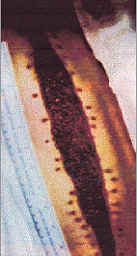Overgranulation
can sometimes occur in the latter stages of healing and clinical action
can help reduce the granulation.
Treatment options

Overgranulation,
also referred to as proud flesh, hypergranulation, hypertrophic granulation,
hyperplasia of granulation tissue or wound oedema, occurs at the
proliferative stage of the wound healing process.
It presents clinically as granulation tissue raised above the level
of the surrounding skin.
- To reduce further development of granulation tissue
- To promote epithelialisation over the surface of the wound
- To effectively manage wound exudate
- To provide a dressing that is comfortable and acceptable to the patient